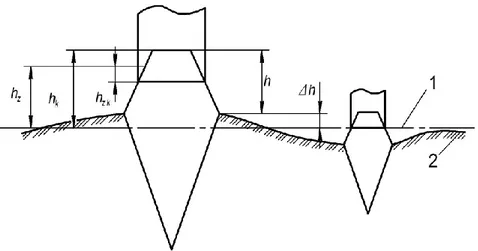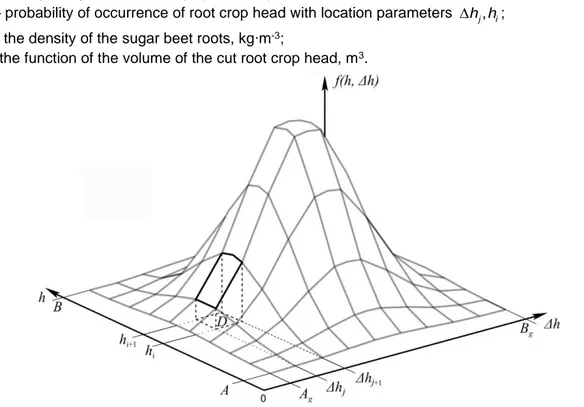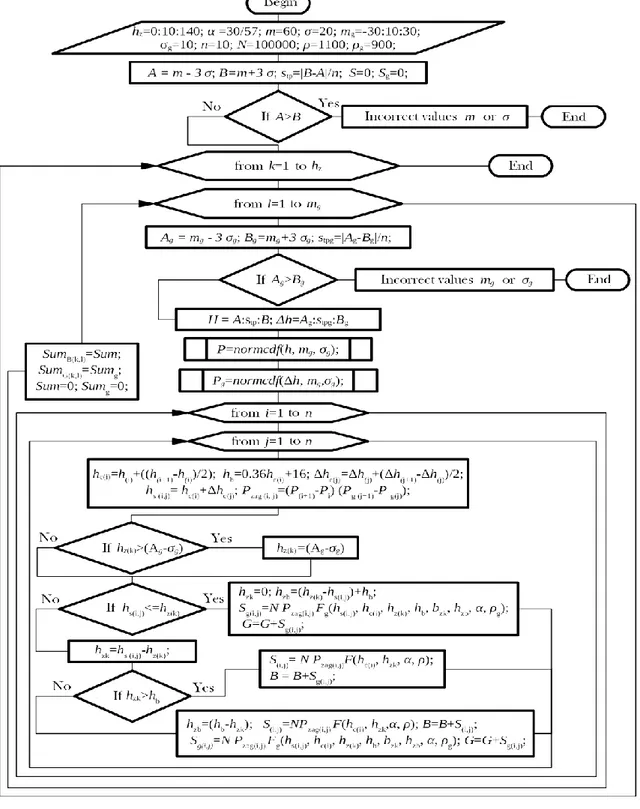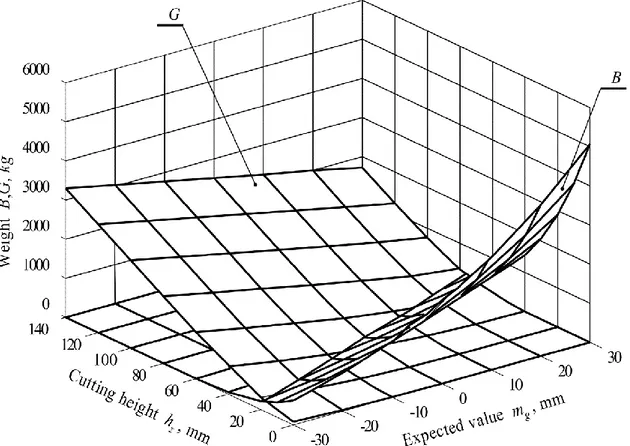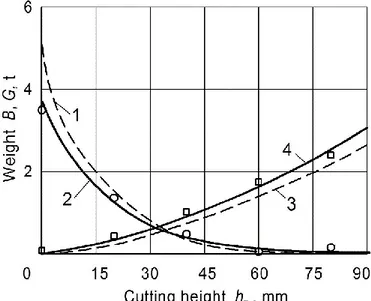A MATHEMATICAL MODEL OF THE CUTTING PROCESS OF THE SUGAR BEET
LEAFY TOPS WITHOUT A TRACER
/
МАТЕМАТИЧНА МОДЕЛЬ ПРОЦЕСУ БЕЗКОПІРНОГО ЗРІЗУ
ГИЧКИ ЦУКРОВОГО БУРЯКУ
Bulgakov V.1), Ivanovs S.2), Pascuzzi S.3), Boris А.4), Ihnatiev Ye5) 1 1) National University of Life and Environmental Sciences of Ukraine;
2) Latvia University of Life Sciences and Technologies; 3) University of Bari Aldo Moro, Italy;
4) National Scientific Centre “Institute for Agricultural Engineering and Electrification” NAAS of Ukraine 5) Tavria State Agrotechnological University, Ukraine
Tel.+37129403708, e-mail: [email protected] DOI: 10.35633/INMATEH-59-04
Keywords: sugar beet, tops, harvesting, loss of mass
ABSTRACT
A method is proposed for the assessment of the effect of the soil surface irregularities upon the loss of mass and the residues of the leafy tops during the sugar beet harvesting process. A new mathematical model is constructed and dependences of the loss of mass and the top residues are obtained depending on the distribution parameters of the soil surface irregularities. The established dependences of the loss of the root crop mass and the residues of the leafy tops on the root crops depending on the statistical distribution parameters of the soil surface irregularities and the cutting height of the tops without a tracer allowed justification of an agrotechnically acceptable level of mathematical expectation of the soil surface irregularities and the cutting height of the root crops without a tracer.
АНОТАЦІЯ Запропонована методика оцінювання впливу нерівностей поверхні ґрунту на втрати маси і залишки гички на головках коренеплодів в процесі збирання цукрового буряку. Розроблена нова математична модель та отримані нові формули втрат маси і залишків гички в залежності від параметрів розподілу нерівностей поверхні ґрунту. Встановлені залежності втрат маси коренеплодів і залишків гички на головках коренеплодів в залежності від параметрів статистичного розподілу нерівностей поверхні ґрунту і висоти безкопірного зрізу гички дозволили обґрунтувати агротехнічне допустимий рівень математичного очікування нерівностей поверхні ґрунту і висоти безкопірного зрізу коренеплодів цукрового буряку. INTRODUCTION
The production of sugar beet and sugar is an important branch of agriculture in the leading states of Europe and America (Marlander B. et al, 2018; Maurus K, et al., 2018, Rajaeirfar M. et al., 2019). Despite the high technical level of development of the modern beet harvesting machinery, there are problems in the process of sugar beet production that need quick solution (Lilleboe D., 2014, Merkes R., 2001). In particular, at the stage of the sugar beet harvesting there are significant losses of the crop (more than 5%), and soiling of the pile of root crops (more than 5%) (Carenko O., Jacun S., 2000; Hoffmann C., 2018). These disadvantages are caused by many factors. However, the main ones are the imperfect technical level of the working tools separating the leafy tops of the sugar beet. It has been found out that increased soiling of a root crop pile with the leaves only by 1% above the agrotechnical requirements reduces the sugar output by 0.1%, and, when storing in clamps with a leafy content of about 4%, the average daily sugar losses amount to 0.02% (Martynenko V.,1996, Zuev N.,1988; Bulgakov V. et al., 2016). Therefore, an important scientific and technical problem is to reduce the loss of mass and residues of the leaves on the root crops. It has been clarified that the soil surface irregularities have a significant impact upon the accuracy of the cutting height of the sugar beet tops without a tracer; however, there are no studies on how they affect the quality indicators of the separation process of the beet tops (Pogorelyi L, Tatjanko N., 2004; Ivančan, S. et al., 2002).
1
A mathematical model is known for predicting the losses of the sugar-bearing mass and the amount of the top residues (Martynenko V., 1996, Bulgakov V. & al., 2015) on the root crops depending on the cutting height without a tracer and the statistical distribution of the protrusion heights of the root crop heads. However, a significant disadvantage of this model is the assumption that the surface of the soil is absolutely flat. Under real conditions, due to imperfect agrotechnics of soil cultivation and many other factors, there are significant soil surface irregularities that have an adverse effect upon the regulation accuracy of the cutting height without a tracer. Therefore, establishment of dependencies between the soil surface irregularities and the loss of mass of the root crops, and the foliage residues on them is an important scientific and practical task. The aim of this work is to develop a mathematical model of cutting the sugar beet tops without a tracer, taking into account the soil surface irregularities. Application of such a model in designing will help reduce the loss of mass of the crop and the residues of the leafy tops in the heap of the root crops.
MATERIALS AND METHODS
In order to establish a relationship between the soil surface irregularities and the performance quality of the top removing machines, the following assumptions were made: for the base (reference) surface we choose a conditional averaged plane of the soil irregularities (Fig. 1), in relation to which the irregularities of the soil were measured, and their distribution does not contradict the normal law. The heights distribution of the protruding root crop heads relative to the soil surface does not deny the normal law either. The top cutting tools move in parallel to the averaged plane of the soil surface irregularities. Let us consider the cutting process of the sugar beet tops without a tracer, taking into account the soil surface irregularities on which they are located. Since in the well-known model (Bulgakov et al., 2015) an absolutely flat surface of the soil is studied, then under real conditions, due to the soil irregularities (depressions and protrusions), an error occurs in setting the height of cutting. To state this error, we consider the following design flow chart (Fig. 1). Let the location of an arbitrary sugar beet root, located in the soil, has deviation from the soil surface
Δh. It can take positive values (protrusions) and negative values (depressions). We will denote the protrusion
height of the root crop head relative to the averaged plane as hk, and the protrusion height of the root crop
head relative to the soil surface as h. The root crop cutting plane relative to the averaged line of the soil surface irregularities will be at height hz.
Fig. 1 – A design flow chart of cutting the sugar beet tops without a tracer, taking into account the soil surface irregularities
1 – the averaged plane of the soil surface irregularities; 2 – the surface of the soil irregularities
To determine the losses of the sugar-bearing mass and the amount of the residues of the tops of an arbitrary sugar beet root, we will determine the thickness of the cut layer of the root crop head hzk.
To determine the loss of the sugar-bearing mass and residues of the tops of an arbitrary sugar beet root crop, we will determine the thickness of the cut layer of the root head hzk.
= −
zk k z
h h h , (1)
or hzk = + −( h h) hz. (2)
Values Δh and h constitute a distribution system of random values the geometric interpretation of which can be represented using the distribution density (Kallenberg, 2005).
The distribution density of a system of two random values according to (Kallenberg, 2005) is determined by the expression:
= 2 ( , ) ( , ) F h h f h h h h , (3)
where F (Δh, h) – the probability function of a combination of random values Δh and h.
We select an arbitrary region from the range (A, B; Ag, Bg) of size n. We take the area of the
protrusion height from A to B, and the area of the soil irregularity distribution from Ag to Bg, and divide them
into n intervals. Then the probability of occurrence of a region with borders (hi, hi+1) (Δhj; Δhj+1) according to
(Bulgakov et al., 2015) will be equal to:
+ + =
1 1 ( , ) ( , ) j i j i h h j i j i j i h h P h h f h h d h dh . (4)Taking into consideration dependence (4), we will write expressions to determine the losses of the sugar-bearing mass Bji and the amount of the residues of the tops Gji for an arbitrary region (hi, hi+1; Δhj, Δhj+1). We have for Bji: − = ( , ) 2 j i ji j i h h B NP h h f , (5)
where N – the quantity of the root crops per 1 ha, pcs∙ha-1;
P – probability of occurrence of root crop head with location parameters ,h h ; j i
ρ – the density of the sugar beet roots, kg∙m-3;
f – the function of the volume of the cut root crop head, m3.
Fig. 2 – A model of the distribution density of the systems of two random values according to the normal law Accordingly, for Gji: − = ( , ) 2 j i ji g j i g g h h G NP h h f , (6)
where Pg – probability of occurrence of root crop head with location parameters ,h h ; j i
ρg– the density of the sugar beet tops, kg∙m-3;
fg – the function of the volume of tops residues, m3.
In general, for the entire distribution region of the systems of random values Δhj and hi with the
statistical characteristics of the protrusion heights distribution of the root crops m and σ, and the soil surface irregularities mg and σg, the losses of the sugar-bearing mass and the amount of the top residues will
= = − =
( , ) 2 g g B B j i j i j A i A h h B NP h h f , (7) = = − =
( , ) 2 g g B B j i g j i g g j A i A h h G NP h h f . (8)Next, we will fix the value of the distribution characteristics of the losses of the sugar-bearing mass and the top residues on the root crops of the mathematical expectation m and the mean-square distribution
σ, and will construct dependencies B, G upon the distribution characteristics of the surface irregularities mg
and σg. To this end, we developed a new algorithm for the mathematical model of the cutting process of the
sugar beet tops without a tracer, taking into consideration the soil surface irregularities (Fig. 3).
The essence of this algorithm is as follows:
1) Preparation and introduction of the following input data and variable factors of the model: hz = (0:
140) – the variation range of the cutting height without a tracer relative to the averaged row line with a 10 mm step, mm; α = 30º – the angle of the taper of the root crop, degree; m = 60 is the mathematical expectation of the protrusion height of the root crop heads with respect to the soil irregularities; σ = 20 – the mean-square deviation of the protrusion height of the root crop heads relative to the soil surface irregularities; mg = (-30: 30) – the variation range of the mathematical expectation of the distribution of the
soil surface irregularities relative to the averaged plane, mm (Fig. 2); σg = 10 – the mathematical
expectation of the distribution of the soil surface irregularities relative to the averaged plane, mm; n = 10 – the discreteness of the model; N = 100000 – the quantity of the root crops per 1 ha, units; ρ = 1100 – the density of the sugar beet roots, kg
∙
m-3; ρg = 900 – the density of the sugar beet tops, kg∙m-3.
2) Calculation of the limits of the protrusion height distribution
A = m - 3σ; B = m+ 3σ.
3) Division of the range h = (A; B) into intervals with a step stp:
− = tp B A s n (9)
4) Starting the cycle for each element of the range hz = (0: 140).
5) Starting the cycle for each element of the range mg = (-30: 30).
6) Division of the range Δh = (Ag ; Bg) into intervals with a step stg:
− = tp g g B A s n (10)
7) Calculation of the value of the integral function for ranges (A; B) (Ag; Bg) by integrating, using the
Simpson method:
P = f (h, m, σ) (11)
Pg = f (Δh, mg, σg) (12)
8) Starting the cycle for each value h. 9) Starting the cycle for each value Δh.
10) Determination of the average value of the interval (hi ; hi+1) hci :
− = + 2 j i ci i h h h h (13)
11) Determination of the average value of the interval (Δhj: Δhj+1) Δhj:
+ − = + 1 2 j i j i h h h h (14)
12) Determination of the height of the base of the green leaves hb:
hb = 0.36 hci + 16 (15)
13) Determination of the protrusion height of the root crop heads relative to the averaged plane hs(i,j):
hs (i,j) = hci + Δhcj (16)
14) Determination of the occurrence probability of a combination of intervals (hi ; hi+1) and
(Δhi ; Δhi+1) Pzag:
Pzag (i, j) = (Pi+1-Pi)
∙
(Pgj+1-Pgj) (17)15) If the cutting height of the root crop heads relative to the averaged plane hz (k) is less than (Ag – σg), then:
hz(k) = (Ag – σg)
16) If the protrusion height relative to the averaged plane hs (i, j) < = hz (k) is less than the current
cutting height, then the root crop is not cut off hzk = 0. We calculate the height of the base of the green
leaves:
hzb = (hz(k) – hs(i,j)) + hb (18)
We determine the amount of the top residues for the combination of intervals (hi ; hi+1) and (Δhi ; Δhi+1):
Sg(i,j) = N Pzag(i,j) Fg(hs(i,j), hc(i), hz(k), hb, bzk, hzb, α, ρg) (19)
We calculate the summary amount of the top residues for the current hz and mg:
17) If hs (i, j) > hz (k), then we calculate the cutting height of the root crop:
hzk = hs (i,j) – hz(k) (21)
18) If hzk > hb, then the amount of the top residues is zero, and we calculate only the losses of the
sugar-bearing mass:
S(i,j) = N Pzag(i,j) F (hc(i), hzk, α, ρ) (22)
We calculate the summary loss of the sugar-bearing mass for the current hz and mg:
B = B + Sg(i,j) (23)
19) If hzk < hb, then the cutting plane passes between the upper part and the base of the green
leaves. We calculate the cutting height of the leafy tops:
hzb = (hb – hzk) (24)
We calculate the amount of the top residues:
Sg(i,j) = N
∙
Pzag(i,j)∙
Fg(hs(i,j), hc(i), hz(k), hb, bzk, hzb, α, ρg) (25)We calculate the losses of mass:
S(i,j) = N
∙
Pzag(i,j)∙
F (hc(i), hzk, α, ρ) (26)We calculate the summary loss of the sugar-bearing mass for the current hz and mg:
B = B + Sg(i,j) (27)
We calculate the summary loss of the tops for the current hz and mg:
G = G + Sg(i,j) (28)
20) Formation of a matrix of values Bk = B, Gk = G.
RESULTS AND DISCUSSIONS
As a result of the implementation of the above algorithm on a PC in the Octave 4.2 environment, there were obtained the following dependences of the losses of mass and the leafy top residues on root crops, depending on the height hz of cutting without a tracer and the mathematical expectation mg (Fig. 4).
Fig. 4 – Response surfaces of the losses of the sugar-bearing mass B and the residues of the foliage G on the root crops, depending on the cutting height hz of the root crops without a tracer and the mathematical
From the resulting graphical dependences (Fig. 4) we see that under the condition that the cutting height is set at the upper level of the soil irregularities and the mathematical expectation is mg = 30 mm
(which corresponds to increased soil roughness), the losses of mass will be 4 t
∙
ha-1 or 8% of the entire rootcrop yield, which exceeds the agrotechnical requirements for the losses of the root crop mass.
Nevertheless, with the indicator mg decreasing to -30 mm (30 mm below the averaged plane), the
losses of the root crop mass will be 0.6 t
∙
ha-1 or less than 2%, which is not a violation of the agrotechnicalrequirements. But in this case the amount of the top residues exceeds the agrotechnical requirements, constituting more than 3 t
∙
ha-1 or 7% of the total root crop mass.On condition that the cutting height is more than 60 mm, the losses of mass do not exceed the agrotechnical requirements of 2% of the total crop mass. However, the amount of the leafy tops on the root crops, if the cutting height is 60 mm, vary from 2 to 7%, in case mg = -30 mm and mg = 30 mm respectively. If
the cutting height hz = 120…140 mm, the residues of the tops will constitute from 5 to 8%.
To confirm the adequacy of the developed new mathematical model for forecasting the losses of the sugar-bearing mass and the residues of the leafy tops during the sugar beet harvesting process without a tracer, preliminary experimental investigations of this process were carried out under real field conditions. The main characteristics of the working area where the experimental studies were conducted are as follows: the yield of the sugar beet root crops - 46.4 t ∙ ha-1; the yield of the leafy tops - 44.8 t ∙ ha-1; the number of the
root crops is 11.2 ∙ 104 pcs ∙ ha-1. Determination of the statistical distribution of the soil surface irregularities
in the sugar beet inter-row spacing by means of a profilograph showed that they are of a high-frequency character with a period of 0.68 m and with an average amplitude of 0.058 m, which corresponds to the mathematical expectation, equal to mg = 30 mm.
Fig. 5 shows the results of experimental investigations (graphs) of the losses of the sugar-bearing mass (Curve 2) and tops residues on the sugar beet heads (Curve 4), processed by statistical methods on a PC, the investigations being carried out in five repetitions for the cutting heights without a tracer in a wide range, namely: 0, 20, 40, 60 and 80 mm. Here similar calculation results are shown for the developed mathematical model, carried out using a PC, which are presented by Curves 1 and 3, respectively, and obtained for the above conditions.
Fig. 5 - Dependence of the theoretical (1, 3) and the experimental (2, 4) values of the losses of the sugar-bearing mass (1, 2) and the remains of tops on the root crops (3, 4)
upon the cutting height without a tracer at mg = 30 mm
Analysis of the curves of theoretical and experimental dependences presented in Fig. 5 shows that in all the five variants of setting of the topping aggregate, tested under real field conditions, the difference between the actual and calculated values does not exceed 7.8%. This coincidence of the experimental and the calculated data points to the adequacy of the developed mathematical model, which gives reason to use it for reliable justification of the cutting height without a tracer.
CONCLUSIONS
A refined mathematical model has been developed for the cutting process of the sugar beet leafy tops without a tracer, taking into account the impact of the soil surface irregularities. Dependences of the loss of the root crop mass and the amount of leafy residues on the root crop tops have been established depending on the parameters of the statistical distribution of the soil irregularities and the cutting height of the tops without a tracer, which make it possible to justify an agrotechnically acceptable level of the mathematical expectation of the soil irregularities mg = -30...10 mm and the cutting height of the root crops hz = 60...70 mm. The conducted verification of the adequacy of the developed mathematical model shows a
discrepancy between the experimental and the theoretical data not exceeding 8%, which gives reason to use it for the justification of the cutting parameters of the sugar beet tops without a tracer within the working range of the cutting heights hz = 20 ... 60 mm.
REFERENCES
[1] Bulgakov V., Ivanovs S., Adamchuk V., Boris A.., (2015), Mathematical model for determination of losses of sugar bearing-mass when sugar beet tops are removed, Engineering for Rural
Development, Proceedings, Vol.14, pp. 41-45, Jelgava/Latvia;
[2] Bulgakov, V., Ivanovs, S., Ruzhylo, Z., Golovach, I., (2016), Theoretical investigations in cleaning sugar beet heads from remnants of leaves by cleaning blade, Engineering for Rural Development, Proceedings, Vol. 15, pp.1090-1097, Jelgava/Latvia;
[3] Carenko O., Jacun S., (2000), Mechanical and technological properties of agricultural materials, 93p, Kiev/Ukraine;
[4] Hoffmann C., (2018), Sugar beet from field clamps – harvest quality and storage loss.
Zuckerindustie, Vol. 143, Issue 11, pp. 639-647, Berlin/Germany;
[5] Ivančan, S., Sito, S., Fabijanić, G. 2002 Factors of the quality of performance of sugar beet combine harvesters. Bodenkultur, 53(3), pp.161-166, Vienna/Austria;
[6] Kallenberg O., (2005), Probabilistic Symmetries and Invariance Principles. 510 p., Springer – Verlag, New York/USA;
[7] Lilleboe D., (2014), Optimizing defoliator & harvester performance, The sugar beet grower. July 2014, 53: pp. 6–13, Fargo/USA;
[8] Marlander B., Hoffmann C., Koch H.-J., Ladewig E., Niemann M., Stockfisch N., Varellmann M., Mahlein A.-K., (2018), Sustainable intensification – A quarter century of research towards higher efficiency in sugar beet cultivation [Nachhaltige Produktivitätssteigerung – ein Vierteljahrhundert Forschung für mehr Effizienz beim Anbau von Zückerruben], Zuckerindustrie, Vol. 143, Issue 4, April 2018, pp. 200-217, Berlin/Germany;
[9] Martynenko V., (1996), Substantiation of the design parameters of the root crop head cleaners,
Materials of the International Conference "Problems and Perspectives for the Development of the Beet Harvesting Machines", pp. 41-44., Vinnica/Ukraine;
[10] Maurus K., Ahmed S., Getz W., Kazda M., (2018), Sugar beet silage as highly flexible feedstock for on demand biogas production, Zuckerindustrie, Vol. 143, Issue 12, December 2018, pp. 691-698; [11] Merkes R., (2001), 50 Jahre Produktionstechnik im Zuckerr. Benbau in Deutchland, Zucker, 4, pp.
214-217, Hannover/Germany;
[12] Pogorelyi L., Tatjanko N., (2004), Beet Harvesters, 232 p., Kiev/Ukraine;
[13] Rajaeirfar M., Sadeghzadeh Hemayati, Tabatabaei, M., Aghbashlo, M., Mahmoudi, S., (2019), A review on beet sugar industry with a focus on implementation of waste-to-energy strategy for power supply, Renewable and Sustainable Energy, Vol. 103, April 2019, pp. 423-442, Tamil Nadu/India; [14] Zuev N., (1988), Cutting the Sugar Beet Heads without a Tracer, Sugar beet, 6. pp. 42-45,
